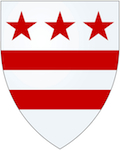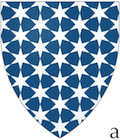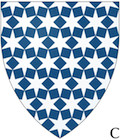Aux armes · symbolism
One touch of nature makes the whole world kin,
That all with one consent praise new-born gawds,
Though they are made and moulded of things past,
And give to dust that is a little gilt
More laud than gilt o'er-dusted.William Shakespeare (c. 1601). Troilus and Cressida.
Nought can deform the Human Race
Like to the Armour's iron brace.
When Gold and Gems adorn the Plow
To peaceful Arts shall Envy Bow.William Blake (c. 1801–3). Auguries of Innocence.
The arms — Azure semy of Mullets of six points conjoined Argent
Medieval heraldry was not much disposed to symbolic representation and, even so, heraldic interpretation remains a vague art with a protean subject. Once evident symbolism has often become obscure or even subverted. Here too, implicit allusions in these arms are confounded with resonant contemporary themes. These can be highly disparate, such as Judaism (the six-pointed stars in the arms) and Nazism (the eagle with expanded wings in the crest); with both devices also being suggestive of similar US symbols.
The pattern shown in the arms has its origins in antiquity and was known in England and Italy from the thirteenth century:1 even so, its heraldic use appears to be unique to these arms, at least in the British Isles. Throughout Europe during the Middle Ages such emblems, whether gilded or silvered, scattered over a blue field were simply taken as indicative of “God's Heavens” and remain ubiquitously symbolic of stars.2
The simplicity of the arms — being a repeated single element — accords with ancient tradition. From the first, the primary purpose of any shield of arms was immediate and unambiguous identification in combat, hence simple and distinctive arms were prevalent, whether of geometrical forms or from a stylized bestiary.
It is paradoxical that in an essentially visual art such as heraldry words should prevail: the descriptions of arms (the blazons) remain canonical and definitive, whereas their actual depiction is freely diverse. As a consequence, renderings of the Geal arms admit substantial variety — yet all are compliant with the blazon, viz.:
Alternative renderings of the arms
Under the Law of Arms these are all allowed artistic variations on the blazon:
a: the customary form.
b: an earlier form, topologically homologous with the preceding figure. The ‘Seven Stars’ badge (see below) still corresponds to this geometry.3
c & d: other renderings, again these are homologues, with the mullets (stars) here ‘conjoined’ in triadic dispositions.
In English heraldry, mullets with more than five points are commonly shown with accentuated points (Figs. a & c) — thus, when with six points, being indistinguishable from the heraldic stars of French (étoile) and German (stern) heraldry. However, the exact shape of mullets is never prescribed.
The form shown in Figure b recalls a beautiful pattern widely-used in Islamic art and architecture. Even so, its immediate antecedents are from medieval Christian EuropeFig 3, although the debt to Islamic exemplars is clear in both these and the arms.
The crest and ‘Eagle and Chain’ badges


Whatever can be said on the arms, the crest and its derivative badge are plainly symbolic, even if variably so. To Christians an eagle is a traditional attribute of St. John the Evangelist and thus evokes a familiar New Testament passage:
… and the truth shall make you free. John 8:32.
Now the eagle would be more widely taken as allusive of the triumph of Liberty over oppression, particularly when combined with a broken chain. In the Middle Ages a broken chain was an heraldic signifier of the release of captives and it remains so in some modern arms, especially in connection with liberation from tyranny (the federal coat of arms of Austria after 1945) and the abolition of slavery (for instance, in the crest of Michaëlle Jean, a former Governor General of Canada).
There is nothing exceptional in this ambiguity, as all symbolism is in basis fanciful. Being a striking and elusive creature, the eagle is an ancient and ubiquitous symbol throughout the northern hemisphere — excepting a few absolutely aniconic sub-cultures. However its particular significance was diverse: for instance, while now prominent in the emblems of the United States, the association of the eagle with liberation would doubtless also have seemed apt to followers of Salah-ad-Din Yusuf ibn-Ayyub (Saladin), the nemesis of the Crusaders. This would have been utterly incongruous to Ancient Greeks and Romans, for whom the eagle was an attribute of Zeus/Jupiter and thus the apotheosis of sovereignty and dominion — especially for the latter, whose legionary Aquila signified imperial military power. This long-standing affinity with hegemony has persisted: as the eagle in the imperial banners of the Byzantine, Holy Roman, Hapsburg and Napoleonic empires attest. Later, the Italian fascist aquila clutching a fasces and the Nazi Reichsadler and Hakenkreuz continued this baleful tradition.
The ‘Seven Stars’ badge

This badge is manifestly an extract from the arms and resembles a long-established English memorial motif — a similar design can be seen in the opus sectile ornamentation on the plinth in the tomb of Henry III and in the Sanctuary pavement in Westminster Abbey.Figs. 1,3 But ultimately the pattern is of Jewish origin, appropriated after contact with Islamic art during the Crusade.
And he had in his right hand seven stars …. Revelation 1:16.
The conjecture that the badge is an intentional representation of the symbol in Revelation 1:16 is tenable, but unsupported by evidence. Similarly, the so-called ‘Flower of Life’4 can be seen as implicit in the badge, although the association is apocryphal and coincidental. But I could be wrong:
A frog in a well cannot conceive of the ocean.
Zhuangzi (莊周) (c. 370–300 B.C.).
Both badges are somewhat unusual in being clearly derived from the arms or crest. More commonly, heraldic badges bear no resemblance to either and are very freely adopted — but such failures of imagination are also common enough.
Neither “Star-Spangled” nor “E pluribus unum”
For some, the combination of stars in the arms and the eagle of the crest will recall those same elements present in the Flag and Great Seal of the United States of America. Despite this similarity, which is plainly more verbal than visual, any connection is illusory: both stars and eagles were widely used in heraldry long before the founding of the USA.
Figure 1: Flag of General George Washington as Commander-in-Chief of the Continental Army.
The flag of George Washington, as Commander-in-Chief during the Revolutionary War, was independently adopted by him in or about 1775. No contemporary blazon for it exists — unsurprisingly, since a royal grant would hardly have been sought nor granted — but this could have served:
Azure Celeste thirteen Mullets of six points three two three two three Argent.
The pattern of the stars, signifying the thirteen States of the Continental Congress, is perhaps also subtly suggestive of the cross of St. George and saltire of St. Andrew of the British Flag. If so, this implied fraternity might have been intentional: the Grand Union Flag — the first national flag of the United States — had the British Union Flag in the canton.
This is the earliest use of stars in an American flag of the Revolutionary War. As it was Washington's personal flag — reputedly to his own design — the stars are widely presumed to be evocative of the stars (mullets) in his adopted arms. However, if this is so, the flag modified this motif, since the stars in the flag are with six points; whereas those in his arms have five points. In the ancestral arms, the stars are also with five points but are "pierced".

Figure 2: Arms of George Washington.
Blazon: Argent two Bars in chief three Mullets Gules.
Another striking similarity is that of the banner of the arms5 and the Union Jack (the Naval Jack of the United States) — although this is merely a fleeting impression, both are quite distinct.

Figure 3: Naval Jack of the United States.
Setting aside this symbolism, the pattern in the arms shows a striking economy of form: the geometry implicit in some alternative renderings of the Arms (Figs. b & d, supra) and in the ‘Seven Stars’ badge can be seen as periodic tessellations of either rhombille or trihexagonal tiling, viz.:
Figures 4a & b: implicit rhombille (4a) and trihexagonal tiling (4b) in the arms
See: Imperfect Congruence. Part 2: Rhomb/rhombus/rhombic tilings.






